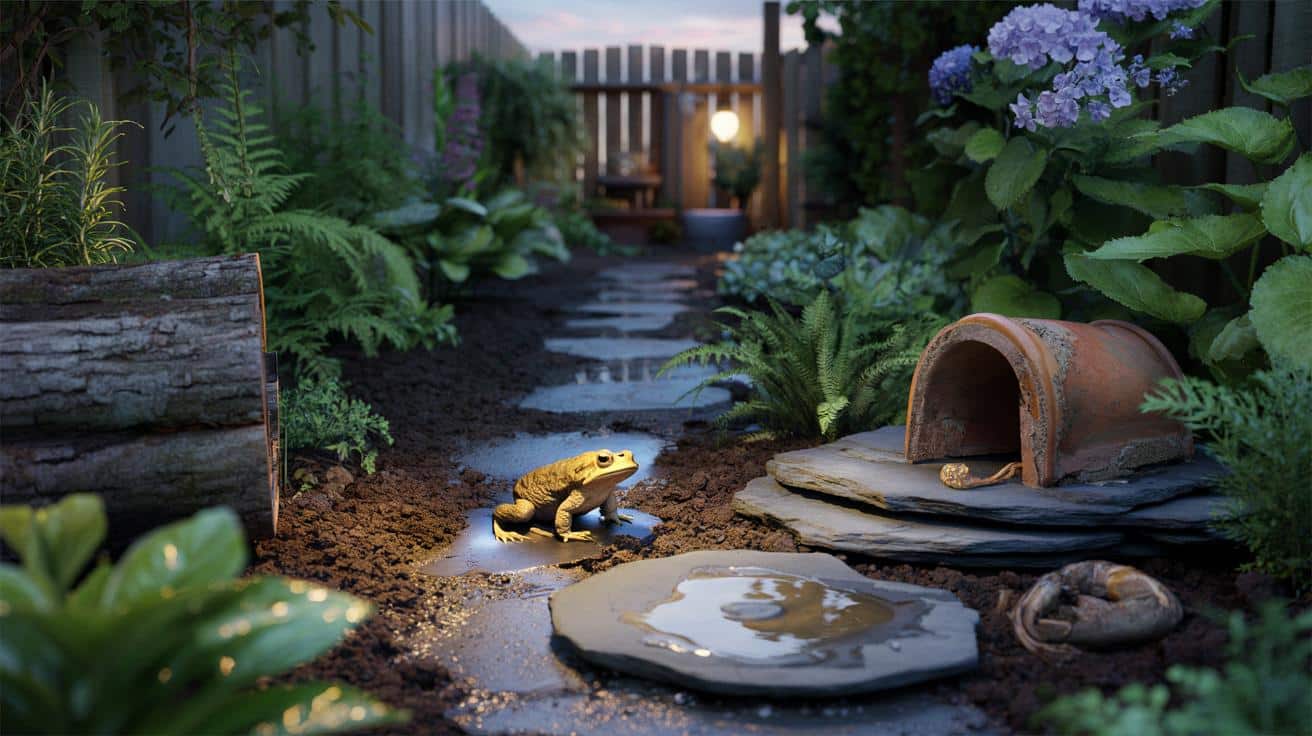Damp fence line, north-facing shed wall, tired patch behind the compost. That’s where the magic can happen. Give that shady spot a little thought and you’ll turn it into a quiet refuge that keeps toads dropping by, night after night.
I first noticed the toad under the foxgloves on a warm June evening, when the lawn still smelled of rain and cut clover. It sat like a small stone with a heartbeat, waiting out the day’s glare, then shuffled forward with a kind of unhurried confidence. Every step looked deliberate. The slugs didn’t stand a chance.
Across the fence, a neighbour’s patio bulb flicked on. The toad hesitated, then melted back into a sliver of shade by the log pile I’d built months earlier. It wasn’t fancy. Bark, leaf fall, one tipped clay pot. Yet that little nook felt like a door into a cooler world. I went inside and turned off the kitchen light. Kept the corner dark. Then it came back.
That’s when I realised: a shady garden corner isn’t wasted space. It’s a working night shift.
Why a shady corner keeps toads coming back
Toads are not sun-lovers. They’re moisture managers. In the heat of day, their skin loses water fast, so they tuck into cool crevices and damp roots where the air is still. A corner that stays shaded is like a mini woodland edge, a place that protects them until the night buffet opens. They anchor there, then range out to hunt.
On our street, the lettuces used to look like someone had taken pinking shears to them. The year I left a log pile against the north fence, slug trails thinned within weeks. I’d count three or four toads most evenings after rain, slow but relentless, hoovering beetles and munching snails. No spray. No traps. Just quiet patrols and cleaner leaves by breakfast.
There’s a simple logic at work. Shade lowers soil temperature and holds humidity, so worms wriggle higher and invertebrates linger. That means food. Dense planting and mulch offer cover, and a clay pot or slate gives a firm roof for a resting toad. The microclimate builds itself: one patch of leafy shade, one patch of damp earth, a shallow water source nearby. Some evenings, the garden feels like it’s breathing.
Build a toad-friendly shady nook
Pick a spot that never gets full sun — along a fence, behind hydrangea, under a sprawled rosemary. Lay a base of bark and leaf litter, then half-bury a broken terracotta pot with a thumb-sized doorway chipped into the rim. Tuck flat stones on top for a cool roof. Add a wide, shallow dish of rainwater, 2–3 cm deep, with a stone in the middle so insects and amphibians can climb out. Top up after dry spells. That’s your **shady, damp shelter**.
Keep it simple. Don’t rake everything bare in spring, and don’t “neaten” your way to a lifeless corner. We’ve all lived that moment where a garden looks pristine and somehow dull. Leave some leaves. Dim nearby lights, especially the blue-white LEDs that bleach the night. If you’ve got close-boarded fences, leave a fist-sized gap at ground level so wildlife can roam. Let’s be honest: no one actually does that every day. Setting it once works better than fussing.
Skip chemicals around the nook. Most slug pellets are off-limits now anyway, and ferric-phosphate versions still make the food chain wonky. Embrace **natural pest control** instead: toads, ground beetles, slow-worms. Keep shallow ramps in any water feature so nothing gets trapped, and mind netting near the ground where limbs can tangle. If you garden with kids, teach them to spot a toad’s steady blink and leave it be. Their patience is contagious.
“Give a toad a cool, dark hideout and it’ll repay you in slug-free mornings. It’s that simple.” — Carla, allotment-holder in Leeds
- Quick checklist: cover, water, darkness, quiet
- Materials: logs, leaves, clay pot, flat stones, rainwater dish
- Keep: gaps for access, mulch for moisture, low lights
- Avoid: tidy mania, pesticides, steep-sided ponds without exits
How the corner changes your whole garden
Once the nook settles, it starts to change your rhythm as a gardener. You notice night life. You water more thoughtfully at dusk to keep the ground sweet. You plant with layers — ferns under shrubs, woodruff under roses — so the shade has depth. The frogs will do daytime cameos. Toads will mostly keep to their shift, hunting quiet, like librarians in boots.
Come late winter, rainy evenings bring the slow migration. If you live near a pond or a ditch, you’ll see them stepping with that stubborn purpose across patios and paths. Leave the corridor open on those nights. No salt. No panicked sweeping. In summer, droughts bite harder now, so that water saucer and mulch matter even more. One small corner becomes a refuge, not just for toads but for you too, when the day runs hot and noisy.
There’s a gentle pride in letting part of your garden go slightly feral. Not scruffy — generous. The best thing? It doesn’t need constant tending. Top up water once a week. Drop a few leaves come autumn. Tweak the doorway if the pot shifts. Your reward is a rhythm you can hear if you listen: a rustle, a soft hop, the hush of a working night. That’s the sound of a living garden. And of **no slug pellets** in your shed.
A small wild patch that keeps giving
This shady corner asks for almost nothing but offers a lot. It gives toads a place to breathe by day and patrol by night. It gives you fewer holes in lettuces and fewer midnight trips with a torch and a moral crisis. It gives the garden a pulse you can feel through your sandals at 10 p.m., when the air cools and the moths rise like ash.
Think about how your space could host an edge — between light and dark, wet and dry, cultivated and left alone. Maybe it’s a ferny pocket behind the bins. Maybe it’s a deep mulch under the apple. Maybe it’s the old cold frame, reinvented as a bunker with a water dish. Share what works on your street. Borrow what works on someone else’s. The corner becomes a conversation, and the conversation becomes a neighbourhood that looks out for small lives. That’s a good way to garden.
| Point clé | Détail | Intérêt pour le lecteur |
|---|---|---|
| Shady refuge | North or east-facing nook with logs, leaves, and a clay pot shelter | Sets up a cool, safe base to keep toads returning |
| Water access | Wide, shallow dish with a stone; top up in dry spells | Supports hydration and wildlife without a full pond |
| Low-intervention care | Dim lights, leave gaps for access, avoid chemicals | Less fuss, better biodiversity, fewer pests |
FAQ :
- Do I need a pond to attract toads?Not for visits. A shallow dish and damp shade will bring them to hunt. For breeding, nearby ponds help, but most toads spend much of the year on land.
- What should I use for a toad house?A broken terracotta pot works brilliantly. Half-bury it, chip a little doorway, and top with stones or slate for a cool roof.
- Will garden lighting scare them off?Bright, cold lights can. Keep the corner dark or use warm, low-level lighting away from the refuge so the night stays gentle.
- Are slug pellets safe if I use the “wildlife-friendly” type?Even ferric phosphate can harm the food web. Better to lean on toads, traps like beer-free barriers, and planting that discourages slugs.
- What about fences and access?Leave a small ground-level gap between gardens so wildlife can roam. Think fist-sized, tucked discreetly behind a plant or log.








Slug patrols without pellets—sold.